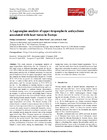A Lagrangian analysis of upper-tropospheric anticyclones associated with heat waves in Europe
dc.contributor.author
Zschenderlein, Philipp
dc.contributor.author
Pfahl, Stephan
dc.contributor.author
Wernli, Heini
dc.contributor.author
Fink, Andreas H.
dc.date.accessioned
2020-12-17T15:32:41Z
dc.date.available
2020-12-16T17:22:47Z
dc.date.available
2020-12-17T15:32:41Z
dc.date.issued
2020-04-28
dc.identifier.issn
2698-4016
dc.identifier.issn
2698-4008
dc.identifier.other
10.5194/wcd-1-191-2020
en_US
dc.identifier.uri
http://hdl.handle.net/20.500.11850/456733
dc.identifier.doi
10.3929/ethz-b-000456733
dc.description.abstract
This study presents a Lagrangian analysis of upper-tropospheric anticyclones that are connected to surface heat waves in different European regions for the period 1979 to 2016. In order to elucidate the formation of these anticyclones and the role of diabatic processes, we trace air parcels backwards from the upper-tropospheric anticyclones and quantify the diabatic heating in these air parcels. Around 25 %–45 % of the air parcels are diabatically heated during the last 3 d prior to their arrival in the upper-tropospheric anticyclones, and this amount increases to 35 %–50 % for the last 7 d. The influence of diabatic heating is larger for heat-wave-related anticyclones in northern Europe and western Russia and smaller in southern Europe. Interestingly, the diabatic heating occurs in two geographically separated air streams; 3 d prior to arrival, one heating branch (remote branch) is located above the western North Atlantic, and the other heating branch (nearby branch) is located over northwestern Africa and Europe to the southwest of the target upper-tropospheric anticyclone. The diabatic heating in the remote branch is related to warm conveyor belts in North Atlantic cyclones upstream of the evolving upper-level ridge. In contrast, the nearby branch is diabatically heated by convection, as indicated by elevated mixed-layer convective available potential energy along the western side of the matured upper-level ridge. Most European regions are influenced by both branches, whereas western Russia is predominantly affected by the nearby branch. The remote branch predominantly affects the formation of the upper-tropospheric anticyclone, and therefore of the heat wave, whereas the nearby branch is more active during its maintenance. For long-lasting heat waves, the remote branch regenerates. The results from this study show that the dynamical processes leading to heat waves may be sensitive to small-scale microphysical and convective processes, whose accurate representation in models is thus supposed to be crucial for heat wave predictions on weather and climate timescales.
en_US
dc.format
application/pdf
en_US
dc.language.iso
en
en_US
dc.publisher
Copernicus
en_US
dc.rights.uri
http://creativecommons.org/licenses/by/4.0/
dc.title
A Lagrangian analysis of upper-tropospheric anticyclones associated with heat waves in Europe
en_US
dc.type
Journal Article
dc.rights.license
Creative Commons Attribution 4.0 International
ethz.journal.title
Weather and Climate Dynamics
ethz.journal.volume
1
en_US
ethz.journal.issue
1
en_US
ethz.journal.abbreviated
Weather Clim. Dynam.
ethz.pages.start
191
en_US
ethz.pages.end
206
en_US
ethz.version.deposit
publishedVersion
en_US
ethz.publication.place
Göttingen
en_US
ethz.publication.status
published
en_US
ethz.leitzahl
ETH Zürich::00002 - ETH Zürich::00012 - Lehre und Forschung::00007 - Departemente::02350 - Dep. Umweltsystemwissenschaften / Dep. of Environmental Systems Science::02717 - Institut für Atmosphäre und Klima / Inst. Atmospheric and Climate Science::03854 - Wernli, Johann Heinrich / Wernli, Johann Heinrich
en_US
ethz.leitzahl.certified
ETH Zürich::00002 - ETH Zürich::00012 - Lehre und Forschung::00007 - Departemente::02350 - Dep. Umweltsystemwissenschaften / Dep. of Environmental Systems Science::02717 - Institut für Atmosphäre und Klima / Inst. Atmospheric and Climate Science::03854 - Wernli, Johann Heinrich / Wernli, Johann Heinrich
en_US
ethz.date.deposited
2020-12-16T17:23:07Z
ethz.source
FORM
ethz.eth
yes
en_US
ethz.availability
Open access
en_US
ethz.rosetta.installDate
2020-12-17T15:32:48Z
ethz.rosetta.lastUpdated
2022-03-29T04:36:29Z
ethz.rosetta.versionExported
true
ethz.COinS
ctx_ver=Z39.88-2004&rft_val_fmt=info:ofi/fmt:kev:mtx:journal&rft.atitle=A%20Lagrangian%20analysis%20of%20upper-tropospheric%20anticyclones%20associated%20with%20heat%20waves%20in%20Europe&rft.jtitle=Weather%20and%20Climate%20Dynamics&rft.date=2020-04-28&rft.volume=1&rft.issue=1&rft.spage=191&rft.epage=206&rft.issn=2698-4016&2698-4008&rft.au=Zschenderlein,%20Philipp&Pfahl,%20Stephan&Wernli,%20Heini&Fink,%20Andreas%20H.&rft.genre=article&rft_id=info:doi/10.5194/wcd-1-191-2020&
Dateien zu diesem Eintrag
Publikationstyp
-
Journal Article [128962]

